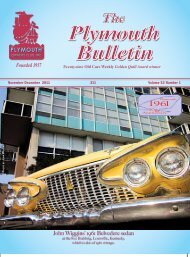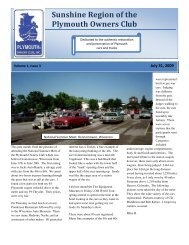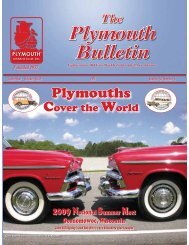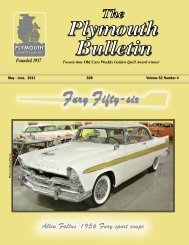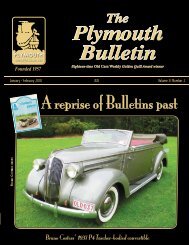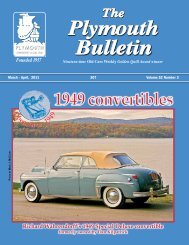296 - FULL ISSUE - Plymouth Club
296 - FULL ISSUE - Plymouth Club
296 - FULL ISSUE - Plymouth Club
- No tags were found...
You also want an ePaper? Increase the reach of your titles
YUMPU automatically turns print PDFs into web optimized ePapers that Google loves.
y Adrian SternLima, PeruI<strong>Plymouth</strong>s of theSouthern HemispherePerubought my 1934 <strong>Plymouth</strong> PEconvertible in June 2003.The car came from a group ofunrestored cars owned by thebiggest collector of antique carshere in Peru.What I know of the history ofthe car is that it came to Perufrom Argentina in the 1980s withsome other antique cars. All ofthem were driven more than 4000miles. After they arrived, they were kept, without beingrestored, in part of the museum warehouse. Finally, with toomany project cars and not too much time, this old car loversold part of his unrestored collection. I bought this car, and,at the same time, my father bought a 1959 German sport car,aBorgward Isabella.Ihave been in the old car hobby since the ‘80s and haverestored a 1929 Model A and a 1934 Ford roadster (which Istill have). I was looking for something different from a Fordbut, at the same time, something that could be driveable.(The Model A, with its inefficient brakes, is something toostressful for today’s driving.) At the same time, I wantedsomething with a beautiful design.When I saw this car, I knew it was the car I wanted. Theproblem I thought I’d have was convincing my wife of buyinganother old car. With this particular case, that wasn’t so difficult.I have to say that my wife’s dad was Argentinean, andBought it! Adrian Stern with his new acquisitionPlease buy itmy wife’s second name is Allende. Well, the plate of the carhas numbers as every plate has, but it also has the name of theplace in Argentina where it came from: Villa Allende (villa inSpanish means a small town). When I told this to my wife,she was amazed of this coincidence and said… “please buyit.”As it has been since I have been in this hobby, I havealways wanted to follow a true restoration--meaning endingwith a car with the exact characteristics as it had when itrolled from the assembly line on its first day--and here camethe problems.When I saw the car in the collector’s warehouse, I noticedthat it was right-hand-driven. That didn’t surprised me, asall cars in Argentina were right-driven until 1949 whenthey decided to change sides. The rare thing was that, aftermaking a more detailed exam of the car,Ifound that thecar was originally left-hand-driven and that the steeringhad been changed. Luckily, it wasn’t that difficult to find anew steering and a central steering arm and return the carto its original condition. Still, I don’t know why, if the carcame from Argentina, it wasn’t imported to that countryright-handed. Maybe its first origin was in another SouthAmerican left-handed country… maybe.Also, when I had the car in my garage and started makingamore thorough exam, I found that originally the car had aworld are not that manybut that we are a reallygreat bunch of guys, don'tyou think so?If anybody wonderswhy I am only saying allthis now, well, it is becauseTPB only gets to me withthis delay--usually...blamethe postal service. Goodthings take their time..ha,ha!So there: congratulations toyou THE PLYMOUTHBULLETIN people!!Lars SorensenValparaiso, ChileTHANKS A LOT for the March-April BULLETIN. Just when Ithought I knew “everything,”along comes that lightgreen/dark green/white roof1956 Dodge Mayfair sedanwith a Custom-Royal typebody side molding pasted onthe side. Is there no end toMoPar weirdness? Also, goodto see that ‘41 De Soto “ute.’Re: De Soto, we had a rareone appear at the annualYpsilanti Orphan Car Show. Itwas a Custom 3-window coupe,cream, with a rare accessory.Most ‘41 De Sotos have, ontheir front fender tops, eithernothing OR that long die-castchrome spear containing theturn signal. This car had neither.Instead, the car had therare “silver streak” chromeand-body-colorornament whichmimicked the trim above andbelow the taillight. The ornamentresembled the fender toptrim used on that DeSoto “ute”shown in the BULLETIN.Congrats! re the GoldenQuill award.Jeff GodshallRoyal Oak, MichiganRoadking mystery y solved-41-Please buy it: The title of Adrian Stern’s article in BULLETIN 295 wasaccidentally deleted.I JUST RECEIVED the March-April BULLETIN and it is great!Also, congratulations on receivingGolden Quill #18!I'd like to thank AdrianStern for his kind commentsabout my helping him. Whathe doesn't talk about is thegreat help he has provided me.I picked up a second ‘34 convertiblea little over a year agoand since then he has had thetop windshield frame piecemade and chrome plated forme. He also had the windshieldwood header bow andthe wood trim that helps holdthe top down to the body made.Oh yeah, did I also mention hemade up a metal bow that wentin my first convertible? I'msure there are a couple of otheritems I don't recall. As he said“For all I am very grateful.”Thanks Adrian.Ed PetersonWalpole, MassachusettsTHANKS FOR FORWARDING Ed’scomments. I want to tell youthat his help was a lot morethan what I did for him. BestRegardsAdrian SternLima, PeruI JUST GOT MY LAST <strong>ISSUE</strong> andam really enjoying it. Theseries about <strong>Plymouth</strong>s of thesouthern hemisphere is excellent.This is different stuff thatis right up my alley. As youmay know, my DeSoto is on theroad, and I'm using it when Ican.Cam ClaytonKaslo, British ColumbiaI WANT TO CONGRATULATE youon the excellent magazine thatissue No. 295 came out to be!A wonderful report on everything<strong>Plymouth</strong> around theworld. Great job; very welldone indeed!This will also show<strong>Plymouth</strong> fans in NorthAmerica that we foreign<strong>Plymouth</strong> fans (FPF for short?)of other places all around the-7-IN THE MARCH-APRIL BULLETIN, page 59, (Jim Benjaminson)asked for identification of the <strong>Plymouth</strong> Roadking emblem.Our family owned a 1940 <strong>Plymouth</strong> Roadking on which Ilearned to drive and kept waxed for many years. This was theonly automobile in our family, and we shared it the entire timewe owned it. I used it on dates and made certain it was polishedeach time I used it. Because of my dedication to a shinyclean car, I am still very familiar with all of its components.The emblem shown was on the center of the dash,attached to the radio delete plate where the radio dials andspeaker were located if you were lucky enough to be able toafford a radio. We did not have the radio, as much as I pleadedmy case with my father. He thought the dashboard lookedjust great with the wood-grained radio delete and the <strong>Plymouth</strong>Roadking emblem occupying the center of the beautiful dash.The emblem was chromed with the ROADKING highlighted inred.The less expensive 1940 Roadking we owned had thisconfiguration which could be removed for the radio and radiogrille to be installed in its place. The Deluxe models had theradio plate installed at the factory which contained the speakergrille and space for the dial and knobs.I am a member of the club but still do not own a<strong>Plymouth</strong>. If I can find a #2 1940 two-door sedan or convertibleor a ‘56 Belvedere hardtop or convertible, I will dislodgea Ford or two and enjoy a <strong>Plymouth</strong>.Bob SchultzState College, Pennsylvania



